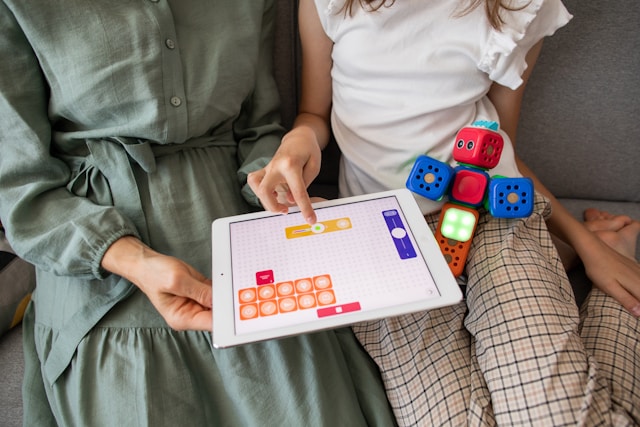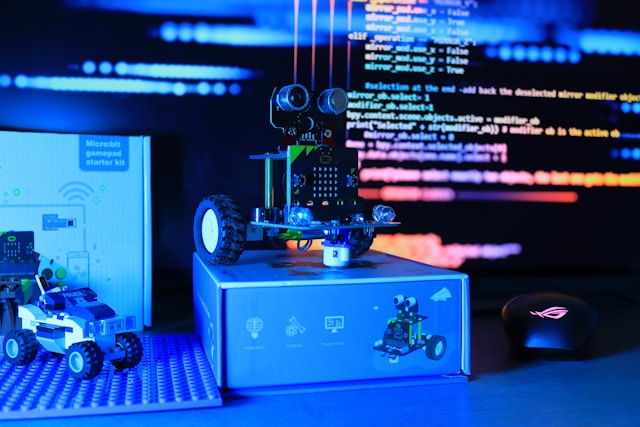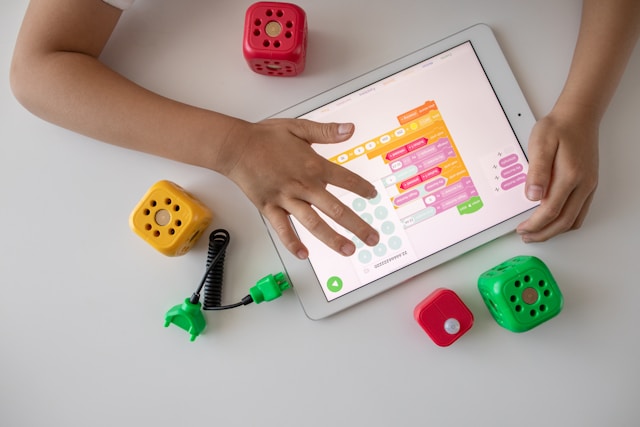Coding education for kids is not a one-size-fits-all endeavor. Just as children develop at different rates and have varying interests, their journey with coding evolves as they grow. In the fast-paced digital world of today, the importance of coding education for children cannot be overstated.
Parents should customize their child’s coding education to their age and developmental stage. From playful introductions to more structured learning, coding education adapts to meet the unique needs and abilities of children at different ages. This ensures their best chance at being successful in learning the concepts and skills for programming.
In this article, we’ll explore the progressive stages of coding education, from early childhood to adolescence, and highlight the key considerations for parents and educators along the way. We’ll also explore how a tailored coding education can ignite a lifelong passion for technology and creativity.
Early Years (Ages 4-7): Laying the Foundation
For children in the early years of their development, coding education is all about laying a solid foundation for future learning. At this age, kids are naturally curious and eager to explore the world around them. Coding activities can be introduced in a playful and hands-on manner, using age-appropriate tools and resources.
Simple games, interactive toys, and hands-on experiences can introduce concepts like sequencing, patterns, and cause-and-effect in a fun and engaging way. Apps and games designed specifically for preschoolers, such as ScratchJr and Kodable, provide age-appropriate introductions to coding concepts through colorful graphics, simple puzzles, and intuitive interfaces.
These activities focus on basic concepts such as sequencing, patterns, and cause-and-effect relationships, helping children develop computational thinking skills in a fun and engaging way. Through activities like coding robots to navigate mazes or creating animated stories, young children begin to understand the logic behind coding and gain confidence in their ability to manipulate technology to achieve desired outcomes.
Tips for Kids Ages 4-7
- Start with hands-on activities
- Focus on basic concepts like patterns
- Learn with ScratchJr and Kodable

Elementary Years (Ages 8-10): Building Skills and Creativity
As children enter the elementary years, their cognitive abilities and problem-solving skills undergo significant development. Coding education at this stage shifts towards building upon the foundation laid in earlier years while introducing more complex concepts and challenges.
Block-based programming languages like Scratch and Blockly provide a hands-on platform for children to experiment with coding concepts while creating projects that reflect their interests and passions.
Hands-on coding classes and coding camps provide opportunities for kids to delve deeper into coding concepts as they create games, animations, and interactive stories. Additionally, coding education at this stage emphasizes creativity and innovation, encouraging children to think outside the box and explore their unique interests and talents. By fostering a balance between structured learning and creative expression, coding education in the elementary years equips children with essential skills for future success in technology and beyond.
Tips for Ages 8-10
- Start with block programming languages
- Focus on creative thinking and problem-solving
- Learn with Scratch and Blocky

Middle School Years (Ages 11-13): Exploring Advanced Concepts
As children transition into middle school, their understanding of coding becomes more sophisticated, and they are ready to explore more advanced concepts and applications. Coding education at this stage goes beyond simple programming exercises to delve into real-world problem-solving and project-based learning. Children start to explore text-based programming languages like Python, which offer greater flexibility and power for expressing their ideas.
In addition to coding activities, middle childhood is also a time for children to start learning about computational thinking, algorithms, and debugging. By engaging in structured activities and challenges, children can develop critical thinking skills, logical reasoning, and resilience in the face of challenges.
Encouraging collaboration and peer learning can also enhance children’s coding experiences, as they share ideas, problem-solve together, and learn from each other’s successes and mistakes. Coding education in middle school can emphasize collaboration and teamwork, as students work on group projects and participate in coding competitions and hackathons.
Tips for Ages 11-13
- Start with text-based coding languages
- Focus on problem-solving and project-based learning
- Learn with structured coding classes and competitions

High School Years (Ages 14-18): Specialization and Preparation for the Future
Coding for teens becomes more specialized as students explore specific areas of interest and prepare for future academic and career paths. High schoolers have the opportunity to dive deeper into programming languages and technologies that align with their interests and career goals, whether it’s web development, game design, artificial intelligence, or cybersecurity. They may also have the opportunity to take Advanced Placement courses for college credit.
Teenagers can start thinking about how coding can be applied to real-world problems and projects. Activities like robotics, game design, web development, and app development allow children to see the practical applications of coding in fields like engineering, design, and entrepreneurship. By engaging in project-based learning experiences, teens can develop critical thinking, problem-solving, and collaboration skills while creating projects that have a tangible impact on their communities.
Coding courses may include advanced topics such as object-oriented programming, database management, and software engineering principles. Additionally, high school students may participate in internships, mentorship programs, and industry certifications to gain real-world experience and enhance their resumes. Coding education in high school not only equips students with technical skills but also fosters critical thinking, problem-solving, and adaptability—the essential qualities needed to thrive in an ever-changing technological landscape.
Tips for Ages 14-18
- Start with why you want to code
- Focus on real-world languages like Python and Java
- Learn with structured coding classes and competitions
A Lifelong Journey of Learning and Discovery
Coding education is a lifelong journey that evolves and adapts to the changing needs and abilities of children at different ages. From laying the foundation in the early years to exploring advanced concepts in high school, coding education provides children with essential skills and competencies for success in the digital age.
By tailoring educational approaches to the developmental stages of children, educators and parents can ignite a passion for technology and creativity that will serve children well throughout their lives. Whether it’s sparking curiosity in young minds or preparing teenagers for future careers, coding education empowers children to unlock their full potential and become creators, innovators, and problem-solvers in a rapidly evolving world.













Leave a Reply